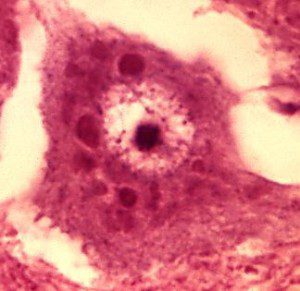

Toll-like receptor 3 (TLR3) is one of many cellular proteins that can ‘sense’ when a cell is infected by a virus. The protein recognizes RNA that is produced during viral infection, and then signals the cell to produce interferons (IFN). IFNs in turn induce the synthesis of many other cell proteins which have antiviral activities. TLRs and IFN are components of the innate immune system, the earliest defense against microbial invaders.
Normally a membrane protein, in cells infected with rabies virus TLR3 is relocated to Negri bodies, which also contain viral proteins and viral RNA. When levels of TLR3 are reduced in rabies-virus infected cells by RNA silencing, Negri bodies do not form, and viral yields are reduced. Therefore TLR3 is required for the formation of Negri bodies. Furthermore, mice lacking TLR3 are less susceptible to rabies virus infection. This result is somewhat counterintuitive, considering the role of TLR3 in detecting RNA virus infections and turning on the IFN system. However, it makes sense because rabies virus replication is reduced in the absence of TLR3.
Why would rabies virus replication depend upon TLR3? One possibility is that Negri bodies are essential ‘factories’ for the assembly of new virions. When Negri body formation is blocked by depleting TLR3, levels of virus production decrease. Sequestration of TLR3 in Negri bodies might also be a mechanism to prevent the protein from inducing the synthesis of IFN. Therefore the presence of TLR3 in Negri bodies has at least two important roles in rabies virus infection.
Negri bodies were first described in 1903 by Adelchi Negri, an Italian pathologist and microbiologist. He would be amazed to learn the important role played by these eponymous bodies in rabies virus replication.
Menager, P., Roux, P., Megret, F., Bourgeois, J., Le Sourd, A., Danckaert, A., Lafage, M., Prehaud, C., & Lafon, M. (2009). Toll-Like Receptor 3 (TLR3) Plays a Major Role in the Formation of Rabies Virus Negri Bodies PLoS Pathogens, 5 (2) DOI: 10.1371/journal.ppat.1000315

This is an interesting finding! If one would want to take this finding to the next step, what sort of questions should be asked? What should be the next step now (future directions). Any ideas?
This is an interesting finding! If one would want to take this finding to the next step, what sort of questions should be asked? What should be the next step now (future directions). Any ideas?
ball canser rocks my world
Â
Looks like you’ve done your research very well.
Since the rabies damage is more of an inflamatory type, I would yield an hypothesis that by blocking TLR3 the inflamation is reduced.
 How about “what would happen if we block RNA synthesis with ribavirin injected intratechally in rabies infected animals? Would negri bodies would still appear?”